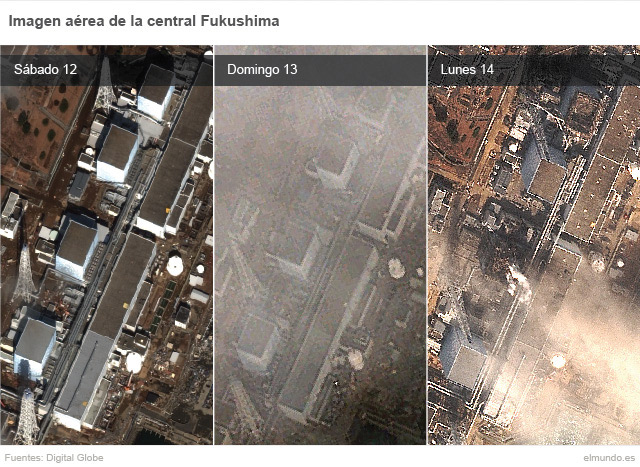The nuclear alert does not stop in Japan and the situation in the Fukushima nuclear power change minute by minute as it continues growing fear that the explosions and fires that have suffered all the reactors at the plant triggering a radioactive leak more. The rise in the levels of radioactivity in the central enclosure for a few hours forced the evacuation of the last 50 workers who remained on campus to register a significant increase in radiation levels, as confirmed by the Japanese nuclear agency.
Operations to cool the reactors was halted temporarily, although already known as the 50 'liquidators' returned to their posts shortly after. It is believed that radiation emissions can come from reactors 2 and 3 of the plant, according to the local agency Kyodo. The level of ionization briefly rose above the 10 millisievert plant at the time on Wednesday morning, and due to the high level of radiation workers had to stop the work of refrigeration.
Part of the structure that protects the reactor number 3 may have been impaired and to be emitting high levels of radiation, as recognized by the Japan Government. Japanese government spokesman, Yuko Edan, also announced that it has authorized to raise the limit to 250 millisievert Fukushima employee by the emergency.
The measure, approved by the Ministries of Health and Labour, has allowed operators to return to work cooling the damaged reactor, although it is unclear whether there will be an impact on health. Hours before the evacuation (first morning in Japan) there has been a new fire in reactor number 4 and Nippon TV shows images of smoke rising from reactor number 3.
Everything indicates that the situation is out of control, the European Commissioner for Energy, Günther Oettinger, has described the situation even apocalyptic. In addition, as happened on Tuesday with the reactor 2, the Japanese government has admitted that there have been fears that damage to the vessel or primary containment wall reactor number 3, as reported in its daily appearance spokesman Yuko Edan.
The vessel is the protection structure closest to the reactor core and is designed to prevent radiation leaks. The new fire in the reactor 4 was discovered by a worker at 5.45 local time (21:45 in the peninsula), but at 8.15 am has been controlled, as confirmed by the Japanese Nuclear Safety Agency.
Hajimi Motujuku, TEPCO spokesman for the utility plant operator, explained that the fire was caused by the combustion of hydrogen from the rods, which were exposed when the water level dropped. The pool temperature reached 84 degrees Celsius, well above the ideal to maintain stable bars, 70% of which have been damaged, according to Kyodo.
The flames have affected the outer barrier of the structure that protects the reactor, according to the version of Motujuku. A power company technicians are concerned about the increase in temperature near the core, are presented, boric acid thrown from helicopters, a fire retardant on the reactor 4.
Initially said the firefighters tried to extinguish the fire, but TEPCO has said that currently the level of radioactivity is too high to send their employees there. Moreover, nuclear fuel rods from reactors 1 and 2 of the troubled plant had been damaged, as reported this morning the Japanese television NHK.
Nuclear fuel rods are in spent fuel pools surrounding each reactor. The damage occurred when exposed to air bars after the fall of water levels are stable and refrigerated, due to power outages caused by the earthquake. In recent times has reduced the amount of fluid and increased pressure within the structures that protect the reactor core, increasing the risk that the rods are unprotected and can produce a fusion process that emit radioactivity.
Tonight's is the second fire to affect the reactor 4, after it was recorded on Monday night. Although the first time the fire was quickly controlled, the blast caused two holes of eight square meters on the exterior building wall of the reactor, allowing contact with air fuel pool. Following this accident, TEPCO said in a press conference that they would try to cool the reactor from helicopters dropping water transfer fluid through the two holes of the building.
This expected to cool the fuel rods inside. The reactor 4 was stopped when the earthquake struck on Friday, so the core fuel had been transferred to the pool of nuclear waste. Since then warming concerns of these spent fuel rods. As it is necessary to cool the core fuel in reactors suffered a sudden stop with the quake (which technicians are now trying to units 1, 2 and 3) spent fuel rods need to be covered with water to cool .
Failure to lower the temperature of the rods, may be damaged and emit radioactive substances. 4 is the only reactor currently has problems that can not be cooled with sea water from near by technical reasons. Japanese media speculated that the excess radioactivity in the ground prevents people from working at the site, hence the operation from the air.
In fact, only 50 remain on the ground of more than 800 people working this morning due to high radiation levels. The 50 experts are still trying to pump seawater to cool the overheated reactor fuel rods and thus avoid a possible meltdown. Another alternative, according to reports, fire trucks would bring it closer to the facility to inject water through holes in the walls. 


Operations to cool the reactors was halted temporarily, although already known as the 50 'liquidators' returned to their posts shortly after. It is believed that radiation emissions can come from reactors 2 and 3 of the plant, according to the local agency Kyodo. The level of ionization briefly rose above the 10 millisievert plant at the time on Wednesday morning, and due to the high level of radiation workers had to stop the work of refrigeration.
Part of the structure that protects the reactor number 3 may have been impaired and to be emitting high levels of radiation, as recognized by the Japan Government. Japanese government spokesman, Yuko Edan, also announced that it has authorized to raise the limit to 250 millisievert Fukushima employee by the emergency.
The measure, approved by the Ministries of Health and Labour, has allowed operators to return to work cooling the damaged reactor, although it is unclear whether there will be an impact on health. Hours before the evacuation (first morning in Japan) there has been a new fire in reactor number 4 and Nippon TV shows images of smoke rising from reactor number 3.
Everything indicates that the situation is out of control, the European Commissioner for Energy, Günther Oettinger, has described the situation even apocalyptic. In addition, as happened on Tuesday with the reactor 2, the Japanese government has admitted that there have been fears that damage to the vessel or primary containment wall reactor number 3, as reported in its daily appearance spokesman Yuko Edan.
The vessel is the protection structure closest to the reactor core and is designed to prevent radiation leaks. The new fire in the reactor 4 was discovered by a worker at 5.45 local time (21:45 in the peninsula), but at 8.15 am has been controlled, as confirmed by the Japanese Nuclear Safety Agency.
Hajimi Motujuku, TEPCO spokesman for the utility plant operator, explained that the fire was caused by the combustion of hydrogen from the rods, which were exposed when the water level dropped. The pool temperature reached 84 degrees Celsius, well above the ideal to maintain stable bars, 70% of which have been damaged, according to Kyodo.
The flames have affected the outer barrier of the structure that protects the reactor, according to the version of Motujuku. A power company technicians are concerned about the increase in temperature near the core, are presented, boric acid thrown from helicopters, a fire retardant on the reactor 4.
Initially said the firefighters tried to extinguish the fire, but TEPCO has said that currently the level of radioactivity is too high to send their employees there. Moreover, nuclear fuel rods from reactors 1 and 2 of the troubled plant had been damaged, as reported this morning the Japanese television NHK.
Nuclear fuel rods are in spent fuel pools surrounding each reactor. The damage occurred when exposed to air bars after the fall of water levels are stable and refrigerated, due to power outages caused by the earthquake. In recent times has reduced the amount of fluid and increased pressure within the structures that protect the reactor core, increasing the risk that the rods are unprotected and can produce a fusion process that emit radioactivity.
Tonight's is the second fire to affect the reactor 4, after it was recorded on Monday night. Although the first time the fire was quickly controlled, the blast caused two holes of eight square meters on the exterior building wall of the reactor, allowing contact with air fuel pool. Following this accident, TEPCO said in a press conference that they would try to cool the reactor from helicopters dropping water transfer fluid through the two holes of the building.
This expected to cool the fuel rods inside. The reactor 4 was stopped when the earthquake struck on Friday, so the core fuel had been transferred to the pool of nuclear waste. Since then warming concerns of these spent fuel rods. As it is necessary to cool the core fuel in reactors suffered a sudden stop with the quake (which technicians are now trying to units 1, 2 and 3) spent fuel rods need to be covered with water to cool .
Failure to lower the temperature of the rods, may be damaged and emit radioactive substances. 4 is the only reactor currently has problems that can not be cooled with sea water from near by technical reasons. Japanese media speculated that the excess radioactivity in the ground prevents people from working at the site, hence the operation from the air.
In fact, only 50 remain on the ground of more than 800 people working this morning due to high radiation levels. The 50 experts are still trying to pump seawater to cool the overheated reactor fuel rods and thus avoid a possible meltdown. Another alternative, according to reports, fire trucks would bring it closer to the facility to inject water through holes in the walls.



No comments:
Post a Comment